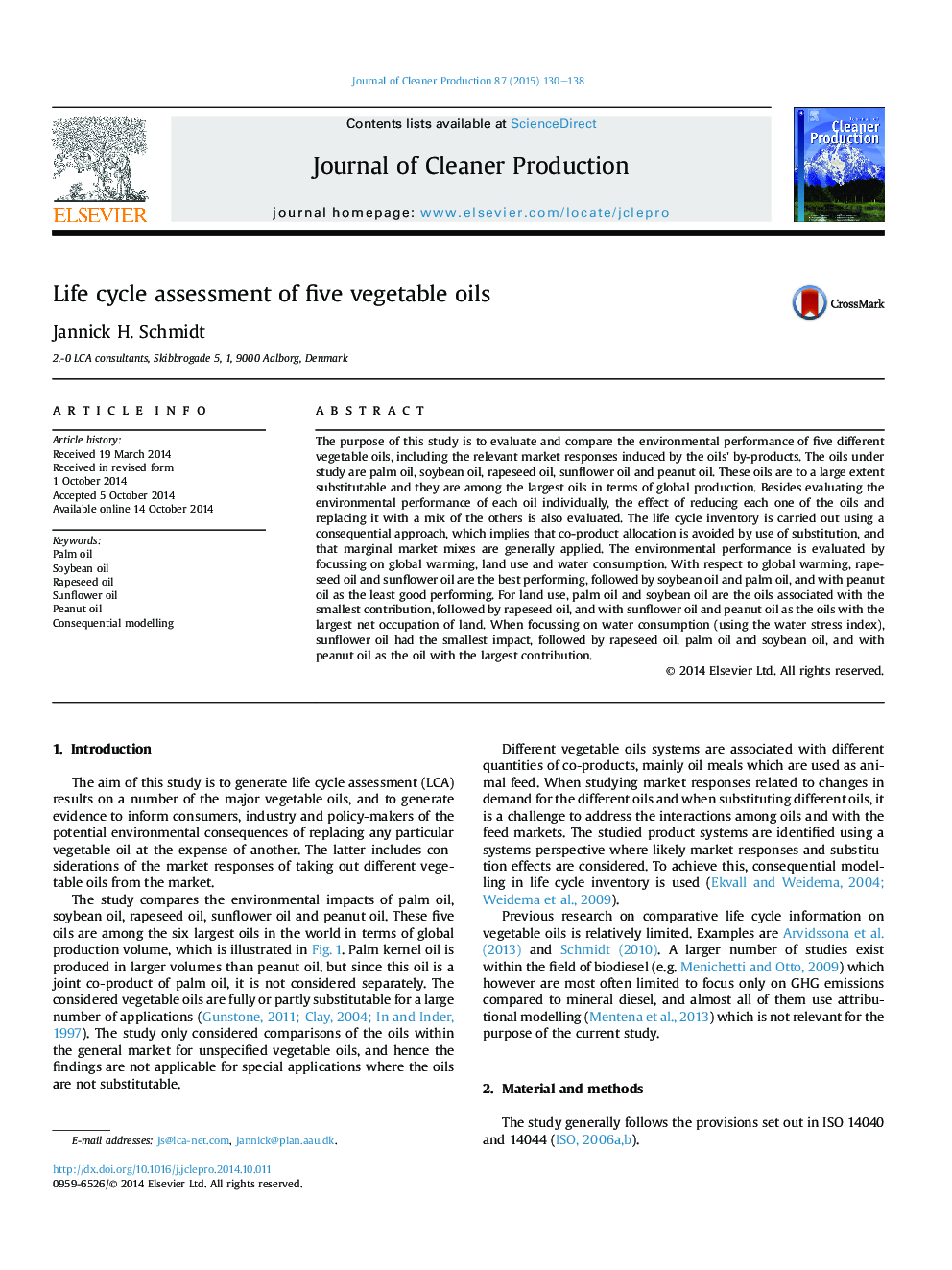| کد مقاله | کد نشریه | سال انتشار | مقاله انگلیسی | نسخه تمام متن |
|---|---|---|---|---|
| 8105103 | 1522159 | 2015 | 9 صفحه PDF | دانلود رایگان |
عنوان انگلیسی مقاله ISI
Life cycle assessment of five vegetable oils
ترجمه فارسی عنوان
بررسی چرخه زندگی پنج روغن گیاهی
دانلود مقاله + سفارش ترجمه
دانلود مقاله ISI انگلیسی
رایگان برای ایرانیان
کلمات کلیدی
روغن نخل، روغن سویا، روغن کلزا، روغن آفتابگردان، روغن بادام زمینی، مدل سازی دلایل،
ترجمه چکیده
هدف از این مطالعه ارزیابی و مقایسه عملکرد محیط زیست پنج روغن مختلف سبزیجات، از جمله پاسخ های بازار مربوطه ناشی از محصولات فرعی روغن است. روغن های مورد مطالعه شامل روغن نخل، روغن سویا، روغن کلزا، روغن آفتابگردان و روغن بادام زمینی می باشد. این روغن ها به میزان قابل توجهی قابل تعویض هستند و از بزرگترین روغن ها در تولید جهانی هستند. علاوه بر ارزیابی عملکرد زیست محیطی هر روغن به صورت جداگانه، اثر کاهش هر یک از روغن ها و جایگزینی آن با ترکیبی از دیگران نیز ارزیابی می شود. موجودی چرخه عمر با استفاده از رویکرد پیوسته انجام می شود، که به این معنی است که تخصیص محصول مشترک با استفاده از جایگزینی اجتناب می شود و مخلوط بازار حاشیه ای به طور کلی اعمال می شود. عملکرد محیطی با تمرکز بر گرمایش جهانی، استفاده از زمین و مصرف آب ارزیابی می شود. با توجه به گرم شدن کره زمین، روغن کلزا و روغن آفتابگردان بهترین عملکرد را دارند، به دنبال روغن سویا و روغن نخل، و با روغن بادام زمینی به عنوان بهترین عملکرد انجام می شود. برای استفاده در زمین، روغن نخل و روغن سویا روغنهایی هستند که با کمترین سهم، به دنبال روغن کلزا و روغن آفتابگردان و روغن بادام زمینی به عنوان روغن با بزرگترین مشاغل خالص زمین است. هنگامی که تمرکز بر مصرف آب (با استفاده از شاخص استرس آب)، روغن آفتابگردان کوچکترین تاثیر را داشت، به دنبال آن روغن کلزا، روغن نخل و روغن سویا و روغن بادام زمینی به عنوان روغن با بیشترین سهم.
موضوعات مرتبط
مهندسی و علوم پایه
مهندسی انرژی
انرژی های تجدید پذیر، توسعه پایدار و محیط زیست
چکیده انگلیسی
The purpose of this study is to evaluate and compare the environmental performance of five different vegetable oils, including the relevant market responses induced by the oils' by-products. The oils under study are palm oil, soybean oil, rapeseed oil, sunflower oil and peanut oil. These oils are to a large extent substitutable and they are among the largest oils in terms of global production. Besides evaluating the environmental performance of each oil individually, the effect of reducing each one of the oils and replacing it with a mix of the others is also evaluated. The life cycle inventory is carried out using a consequential approach, which implies that co-product allocation is avoided by use of substitution, and that marginal market mixes are generally applied. The environmental performance is evaluated by focussing on global warming, land use and water consumption. With respect to global warming, rapeseed oil and sunflower oil are the best performing, followed by soybean oil and palm oil, and with peanut oil as the least good performing. For land use, palm oil and soybean oil are the oils associated with the smallest contribution, followed by rapeseed oil, and with sunflower oil and peanut oil as the oils with the largest net occupation of land. When focussing on water consumption (using the water stress index), sunflower oil had the smallest impact, followed by rapeseed oil, palm oil and soybean oil, and with peanut oil as the oil with the largest contribution.
ناشر
Database: Elsevier - ScienceDirect (ساینس دایرکت)
Journal: Journal of Cleaner Production - Volume 87, 15 January 2015, Pages 130-138
Journal: Journal of Cleaner Production - Volume 87, 15 January 2015, Pages 130-138
نویسندگان
Jannick H. Schmidt,
